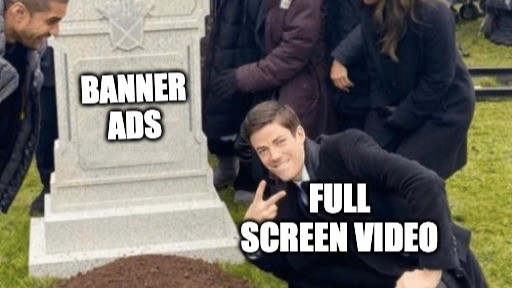About the author call_made
Felix Braberg
Mobile Ad Revenue expert, podcaster, and passionate about all things mobile.

HighlightsJournal 26 Felix Braberg September 10

After years of working in mobile ad monetization, one trend stands out above the rest: banners are on a death march into oblivion as a monetization source. Banners’ overall contribution margin in the ad monetization pie is decreasing. Looking at the former hypercasual titan Voodoo, once known for monetizing heavily with banners, it’s clear the format is starting to fall behind. Their latest surprise hypercasual hit, Epic Plane Evolution, completely ditches the format, favouring IAPs, Interstitials, and Rewarded Videos. So what’s happening with Banners on mobile?
Ad networks have aggressively doubled down on full-screen video formats since 2020. Rewarded videos and interstitials are becoming increasingly longer and more challenging to skip; rewarded ads now often run past 60 seconds and include end cards that require 10 seconds and four clicks to exit. That friction drives higher conversion rates, which fuels advertiser demand, which in turn lifts eCPMs, making the formats more attractive to publishers. Banners have no such flywheel. The format looks almost the same as when it launched on mobile, and the market is treating it accordingly. Today, I estimate that Interstitial ads account for about 50% of overall revenue, with Rewarded ads accounting for 35% while banners account for only about 15% of overall ad revenue.
Banners are also under pressure on the delivery side. Leading mediation platforms now let publishers cut refresh rates from 30 seconds down to just 5 or 10. On paper, this triples or even quadruples impressions per DAU, but in reality, it just floods the system with low-quality views. The result is fewer meaningful clicks, weaker conversion rates, and ultimately lower eCPMs.
The final nail in the coffin for banners is on the demand side. For years, Google was the undisputed king of banner ads. But over the past two years, Amazon Publisher Services has quietly taken the top spot in the U.S. and EU. The catch? APS is invite-only, and access is limited to a lucky few. To make matters worse, on June 4, they abruptly cut 100 of their top publishers without warning. A brutal reminder that even the best banner demand source is unstable and out of reach for most publishers.
I recently spoke with an ad monetization manager overseeing a portfolio that pulls in more than $500k per day in ad revenue, and he summed it up perfectly: “With the transition to hybrid monetization, banners just aren’t worth it anymore.”
Everything in mobile gaming eventually comes back to UA and how sharp your UA is. That’s why once a month, we run a special 2.5 Gamers episode covering the latest creative trends from some of the biggest titles in the industry. In July, leaders like Royal Match and King Shot leaned hard into AI hooks, even superimposing AI characters directly into their creatives.
We also spotted a few new (and old) creative Trends re-emerging: the “rotten fruit” slicing trend is back, ads are experimenting with “slice everything” mechanics mixed with Golden Goblinsphysics, and street interview formats are popping up as one of the hottest concepts right now. On top of that, rewarded ads are still getting longer than ever, with some running past 60 seconds, attempting to entice users with high-production-value creatives and storytelling that push viewers to conversions. Check out our highly anticipated Creative Trends Episode.

This is usually the section that I save for solo-developed games that have managed to climb the download charts by leveraging beautiful ad revenue. This week, I wanted to highlight another interesting game: Acecraft.

Acecraft by Moonton Games launched on the 26th of August. It takes a Cuphead-style 1930s art direction and merges it with a classic shoot ’em up core loop. It’s been 15 days since its launch, and it’s already managed to scale to $250k/day in IAPs and about $25k/day in ad revenue. The game is designed with deep gacha loops similar to Genshin Impact and Honkai: Star Rail, a battle pass that feels like one of the best upsells I’ve seen, and layered progression systems that keep players engaged for the long run.
The game leans heavily into modern mobile trends, including a web store that bypasses Apple and Google’s platform fees. Like Habby, it’s shifting away from ad revenue and doubling down on IAPs as the primary driver. After some digging, I also confirmed that Acecraft isn’t running through Google, AppLovin, or Unity for mediation; instead, it’s using TopOn from Mobvista.

About the author call_made
Mobile Ad Revenue expert, podcaster, and passionate about all things mobile.
Please login or subscribe to continue.
No account? Register | Lost password
✖✖
Are you sure you want to cancel your subscription? You will lose your Premium access and stored playlists.
✖